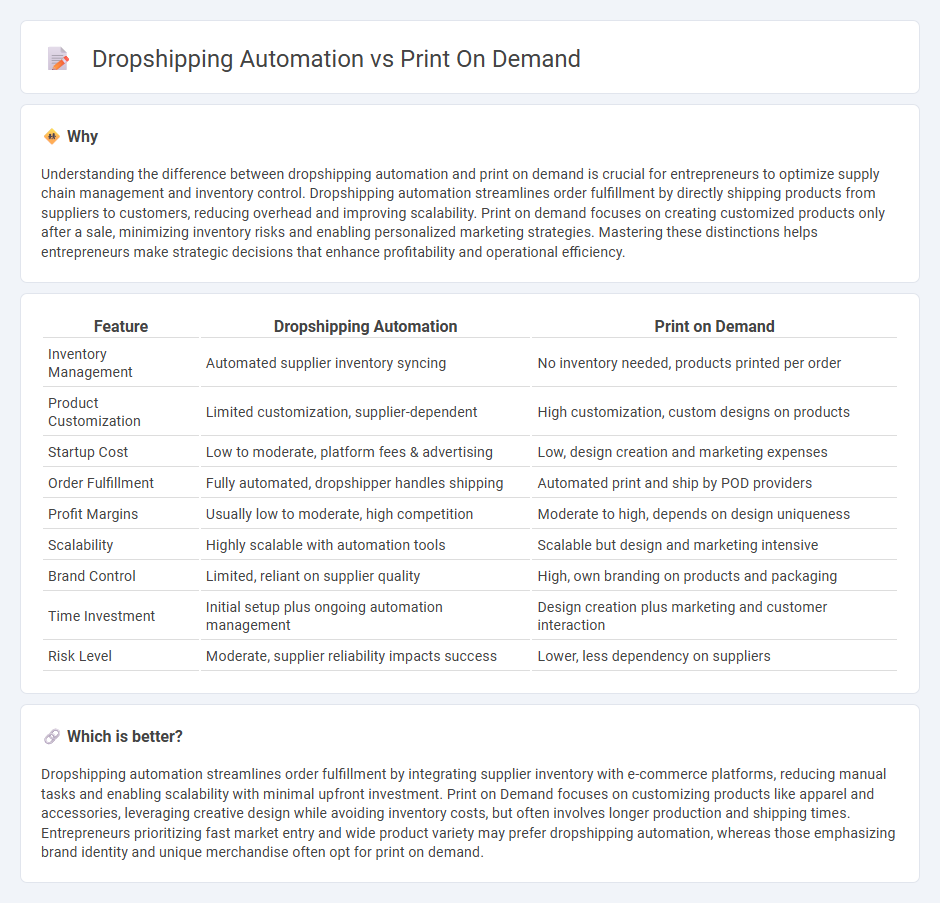
Dropshipping automation streamlines inventory management and order fulfillment by integrating supplier data directly with e-commerce platforms, reducing manual workload and enhancing scalability. Print on Demand focuses on custom product creation, allowing entrepreneurs to design and sell personalized items without holding inventory, leveraging automated printing and shipping processes. Explore the differences and advantages of these business models to determine which suits your entrepreneurial goals best.
Why it is important
Understanding the difference between dropshipping automation and print on demand is crucial for entrepreneurs to optimize supply chain management and inventory control. Dropshipping automation streamlines order fulfillment by directly shipping products from suppliers to customers, reducing overhead and improving scalability. Print on demand focuses on creating customized products only after a sale, minimizing inventory risks and enabling personalized marketing strategies. Mastering these distinctions helps entrepreneurs make strategic decisions that enhance profitability and operational efficiency.
Comparison Table
| Feature | Dropshipping Automation | Print on Demand |
|---|---|---|
| Inventory Management | Automated supplier inventory syncing | No inventory needed, products printed per order |
| Product Customization | Limited customization, supplier-dependent | High customization, custom designs on products |
| Startup Cost | Low to moderate, platform fees & advertising | Low, design creation and marketing expenses |
| Order Fulfillment | Fully automated, dropshipper handles shipping | Automated print and ship by POD providers |
| Profit Margins | Usually low to moderate, high competition | Moderate to high, depends on design uniqueness |
| Scalability | Highly scalable with automation tools | Scalable but design and marketing intensive |
| Brand Control | Limited, reliant on supplier quality | High, own branding on products and packaging |
| Time Investment | Initial setup plus ongoing automation management | Design creation plus marketing and customer interaction |
| Risk Level | Moderate, supplier reliability impacts success | Lower, less dependency on suppliers |
Which is better?
Dropshipping automation streamlines order fulfillment by integrating supplier inventory with e-commerce platforms, reducing manual tasks and enabling scalability with minimal upfront investment. Print on Demand focuses on customizing products like apparel and accessories, leveraging creative design while avoiding inventory costs, but often involves longer production and shipping times. Entrepreneurs prioritizing fast market entry and wide product variety may prefer dropshipping automation, whereas those emphasizing brand identity and unique merchandise often opt for print on demand.
Connection
Dropshipping automation streamlines order fulfillment by integrating supplier inventory with e-commerce platforms, while Print on Demand customizes products only after purchase, minimizing inventory risk. Both models leverage automated systems to reduce manual tasks, enhance scalability, and optimize supply chain efficiency. Their synergy enables entrepreneurs to efficiently manage personalized product sales without upfront stock investment.
Key Terms
Product Customization
Print on Demand enables extensive product customization with personalized designs directly printed on items, enhancing customer engagement and brand uniqueness. Dropshipping automation primarily focuses on streamlined order fulfillment but offers limited options for product personalization due to reliance on third-party suppliers. Discover the advantages and challenges of each model to optimize your e-commerce strategy effectively.
Order Fulfillment
Print on Demand and Dropshipping automation streamline order fulfillment by minimizing manual processing through real-time integration with suppliers and inventory systems. Print on Demand automatically generates custom products once an order is placed, eliminating the need for inventory storage, while Dropshipping automates product sourcing directly from third-party warehouses to the customer. Explore how advanced fulfillment technologies can enhance efficiency and customer satisfaction in your e-commerce operations.
Inventory Management
Print on Demand automates inventory by producing products only after a customer places an order, eliminating the need for stock storage and reducing overstock risks. Dropshipping automation relies on real-time inventory updates from suppliers, requiring seamless integration to prevent stockouts and ensure order fulfillment accuracy. Explore our detailed comparison to optimize your inventory management strategy effectively.
Source and External Links
What Is Print on Demand and How To Start a Business (2025) - Print on demand is a business model where products are designed by the seller and produced by the supplier only once an order is placed, involving steps such as designing, selecting products, listing them for sale, and outsourcing printing, packing, and shipping to a provider.
Print on Demand for Individuals and Brands | 370+ Products - Print on demand allows creating custom products with no minimum order quantities, where items are printed, packaged, and shipped directly to customers, making it a low-risk ecommerce model suitable for individuals and brands alike.
Print on Demand & DropShipping Platform | 1000+ products - Printify - Print on demand requires no upfront investment or inventory, enabling sellers to reach customers worldwide with custom products, but it also involves potential downsides like longer fulfillment times and limited control over product quality.
 dowidth.com
dowidth.com